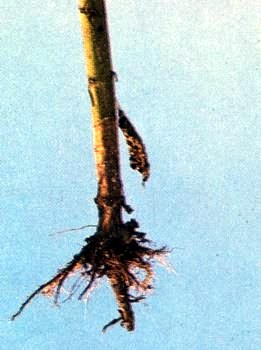Diseases
Fusarium sp., Rhizoctonia sp. - Root Rot of Sunflower
Systematic position.
Class Deutoromyces, order Hyphomycetales, genus Fusarium; order Agonomycetales, genus Rhizoctonia.Biological group.
This species is a facultative parasite.Morphology and biology.
The causatives agents of the Root Rot of sunflower of the genus Fusarium have in their life cycle colorless or painted mycelium forming macro- and microconidia. Macroconidia are usually formed on adjacent conidiophores covered with slime, i.e., in sporodochia or pionnotas. They have 3 to 7, and sometimes more, septa. Microconidia have up to two septa formed on simple and branched conidiophores. Pathogens of the genus Rhizoctonia form brown mycelium and black sclerotia variable in shape on affected tissue. Sometimes they can form basidial sporulation of thanatephorus type. Diagnostic symptoms of the Root Rot of sunflower are dark necrosis on roots and basal parts of stems and later rot penetrating inside stems. This results in quick destruction of young plants or gradual wilting and early drying of sunflowers. The initial infection of causatives agents are maintained in soil, in affected organic residues and in seeds.Distribution.
Root Rot of sunflower is spread everywhere throughout Russia and other countries of the former USSR. Causatives agents of the genus Fusarium are found on sunflower more often than others.Ecology.
The causatives agents of the Root Rot of sunflower are soil inhabitants. Damp clay soil at temperatures 18-28 and pH 3.5-5.0 are most favorable for infection of sunflower by pathogens.Economic significance.
The pathogens cause the thinning of sunflower and premature drying and they can reduce yield by 10 to 50%. The greatest harm the disease causes is in the Northern Caucasus. The optimum rotation of sunflower and the pre-sowing treatment of seeds are recommended to control the Root Rot.Reference citations:
Antonova T.S., Maslienko L.V., Muradosilova N.V., Saukova S.L. 2002. Species of fungi of the genus Fusarium meeting on sunflower in Krasnodar Territory and their pathogenicity. Modern Mycology in Russia. Moscow: NAM RF. 171 p. (In Russian).Bilai V.I. 1977. Fusarium. Kiev: Naukova dumka. 742 p. (In Russian)
Kukin V.F. 1982. Diseases of sunflower and their control. Moscow: Kolos. 80 p. (In Russian)
Maric A., Camprag D., Masirevic S. 1987. Sunflower diseases and pests and their control. Beograde: Nolit. 379 p. (In Serbian)
Peres A., Poisson B., Drolon G. 2000. Root Rot of sunflower: Study of causes and harmfulness. In: Anonymous, ed. 15th Int. Conf. on Sunflower. V. 2. Toulouse-France: ISA. 17-21 p. (In French)
Yakutkin V.I. 1995. Fusariosis of sunflower and problem of phytosanitary monitoring of the disease in Russia. In: Novozhilov K.V., ed. All-Russian Congr. on Plant Prot., Abstracts; Dec. 1995; St. Petersburg. 108-109 p. (In Russian)
Yakutkin V.I. 2001. Diseases of sunflower in Russia and their control. Zashchita i karantin rastenii, 10: 26-29. (In Russian)
© Yakutkin V.I.


